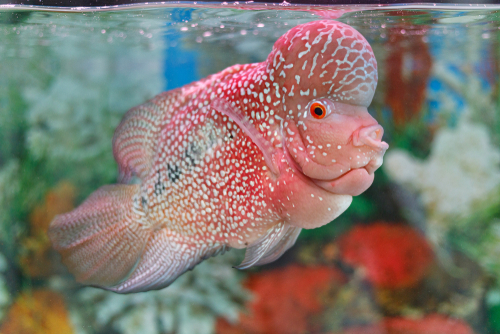The Flowerhorn Cichlid is lovely, even with the prominent forehead! Though this fish may look like the bell of the ball, it is natural for you to want a variety in your tank. The question is: which are the 15 best flower horn tank mates?
The 15 best flower horn tank companions are fish that are similar in size to the flower horn fish, such as other cichlids. These ensure that the flower horn cichlid will not be bullied or starved.
In this article, we’ll cover the best 15 flowerhorn tank mates as well as some FAQs!
Contents
Flowerhorn Tank Mates – What You Need to Know
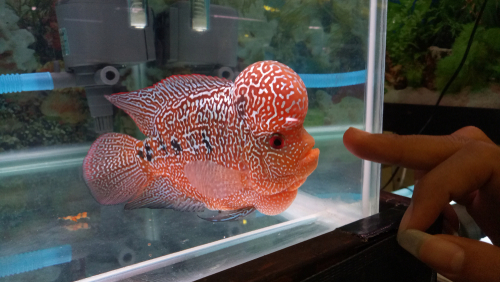
If you are going to invest in flower horn tank mates, the first thing you need to do is get to know your flower horn! Once you understand the flower horn’s needs in terms of space, food competition, and temperament, you’ll be capable of picking out the best tankmate.
Temperament
The flower horn cichlid is known for an aggressive temperament. The only way to keep this fish happy and healthy is, ironically, finding other fish with a similar temper! The same way you and I benefit from a housemate who can dish it out and take it, the flower horn cichlid benefits from other aggressive breeds.
Size
If you decide on a tank mate who is smaller than the flower horn cichlid, watch out! Your flower horn cichlid is full of spunk and appetite, as well as territorial, particularly is he is a male. Smaller fish are likely to be killed or bullied intensely.
What you need are fish that are large and sturdy enough to hold their own against the flower horn cichlid. Since flower horn cichlids can reach up to 12 inches in length, you will want a fish at least that big. In fact, getting one that is slightly bigger may be an even better course of action.
Competition
Another problem that can come along with bullying if you choose improper tank mates are fish that compete for the same sources of food your flower cichlid needs. Of course, this cuts both ways, as the flower cichlid is not above stealing other fish’s food.
The best thing to do is take each tank mate’s diet into consideration when picking them out to share space. Otherwise, you may wind up with a starving fish in your little ecosystem.
Parameters ; Tank Setup
When we talk about parameters and tank setup, we simply mean the flower horn cichlid’s needs in terms of water temperature and space. What might be paradise for one fish can be a death sentence for a different species.
The flower horn cichlid needs water that is warmer than your typical human room temperature: around 75 to 82 degrees Fahrenheit. Couple that with large tank sizes to accommodate their larger size, and you will probably need several heaters.
For this reason, flower horn cichlid tank mates need to have a tolerance for around the same temperature and should be comfortable in the same space.
15 Best Flowerhorn Tank Mates
Now that we have covered exactly what needs should be considered when getting the perfect flower horn cichlid tank mates, we can list the best fish that fit the description!
- Jaguar Cichlids
- Midas Cichlids
- Pacu Fish
- Wolf Cichlid
- Texas cichlid
- Oscar Fish
- Acara cichlid
- Common Pleco
- Blood Red Parrot cichlid
- Three Spot Cichlid
- Silver Arowana
- Bichir Dragonfish
- Giant Gourami
- Clown Loaches
- Green Terror Cichlid
We’ll take a closer look at each of these fish species so that you can know the particulars of their needs and the pros and cons to keeping them with your flower horn cichlids.
Other popular posts you will like:
1. Jaguar Cichlids
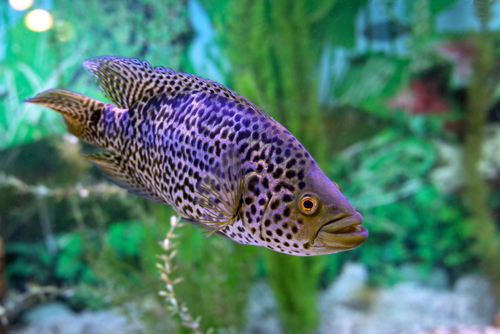
- Scientific Name: Parachromis managuensis
- Adult Size: 16 to 26 inches
- Compatible With: All Flower Horns
- Water Temperature: 77 to 97 F
- Minimum Tank Size: 70 gallons
- Care Level: Easy
- Origin: Honduras, Central America, Costa Rica
The jaguar cichlid is one of the flower horn cichlid’s relatives who can handle the attitude that a flower horn wants to send its way! Its black, gold, and silver pattern also make it a pleasing contrast to the flower horn’s bright colors. Just remember not to add in too much foliage for the jaguar to rip up.
Pros of keeping with Flower Horn:
- Large enough to discourage flower horn cichlid’s attacks.
- Is unlikely to attack flower horns of a similar size.
Cons of keeping with Flower Horn :
- Will destroy any plants in the tank.
2. Midas Cichlids
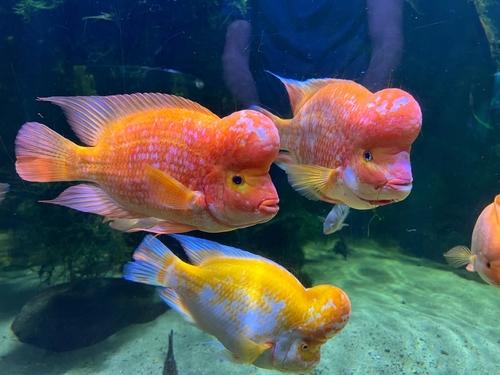
- Scientific Name: Amphilophus cirtinellus
- Adult Size: 10 to 14 inches
- Compatible With: All Flower Horns
- Water Temperature: 72 to 82
- Minimum Tank Size: 125 gallons
- Care Level: Easy
- Origin: Central America
These other members of the cichlid family are named for their bright yellow coloring. Their foreheads are not quite as protruding as their relatives. They eat both plants and meat, so they must be kept with other fish of a similar size, like the flower horn!
This way, the two territorial fish types can avoid one another rather than duel because they’ll simply size one another up, see the similarities in bulk, and decide not to bother.
Pros of keeping with Flower Horn:
- Large enough to prevent bullying from the flower horn.
- Small enough to avoid bullying flower horns, themselves
Cons of keeping with Flower Horn :
- None!
3. Pacu Fish
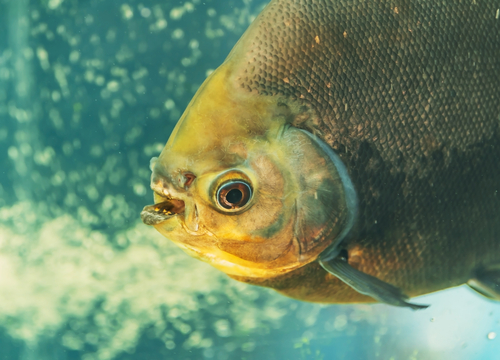
- Scientific Name: Tambaqui
- Adult Size: 2 to 3 inches
- Compatible With: All Flower Horns
- Water Temperature: 72 and 80 F
- Minimum Tank Size: 200 gallons
- Care Level: Medium Difficulty
- Origin: South America
These fish will add great visual interest to the fish tank. They have interesting, human-like teeth and are not afraid to defend themselves, making them the perfect companions to the pushy flower horn. They are also omnivorous.
Pros of keeping with Flower Horn:
- Large enough to prevent flower horn bullying
- Small enough to avoid challenging flower horns
Cons of keeping with Flower Horn :
- None!
4. Wolf Cichlid
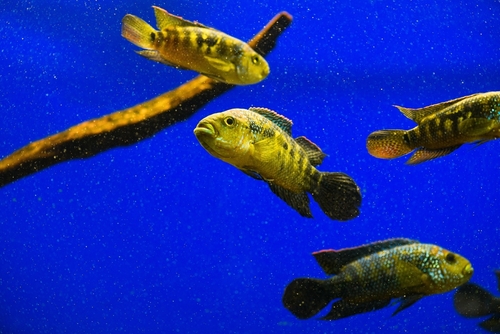
- Scientific Name: Parachromis dovii
- Adult Size: 28.3 inches
- Compatible With: All Flower Horns
- Water Temperature: 75 to 82 F
- Minimum Tank Size: 100 gallons
- Care Level: Easy
- Origin: Central America
Who’s afraid of the big bad wolf cichlid? Pretty much everybody, actually; the wolf cichlid is actually one of the most aggressive types of fish that can be found in a tank. The truth is, the wolf cichlid cannot be kept with very many fish, but the flower horn is one of the exceptions! These fish have similar temperaments that keep one another safe.
Pros of keeping with Flower Horn:
- Color Pattern goes well with flower horn
- Size will discourage bullying
Cons of keeping with Flower Horn :
- None, as long as Flower Horn is fully mature.
5. Texas cichlid
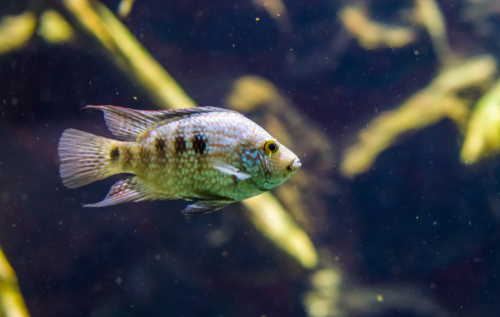
- Scientific Name: Herichthys cyanoguttatus
- Adult Size: 13 inches
- Compatible With: All Flower Horns
- Water Temperature: 68 to 82 F
- Minimum Tank Size: 125 gallons
- Care Level: Easy
- Origin: United States
The Texas cichlid is very pretty, covered in a delicate spray of spots and long fins without much of a characteristic head hump. Not only does it’s size and territorial attitude make it a good tank mate for the aggressive flower horn, but it can also survive in a wide range of temperatures, making it easy to care for.
Pros of keeping with Flower Horn:
- Large enough to discourage infighting
- More subtle color pattern to offset flower horn’s color
- Capable of adapting to warm temperatures
Cons of keeping with Flower Horn :
- None!
6. Oscar Fish
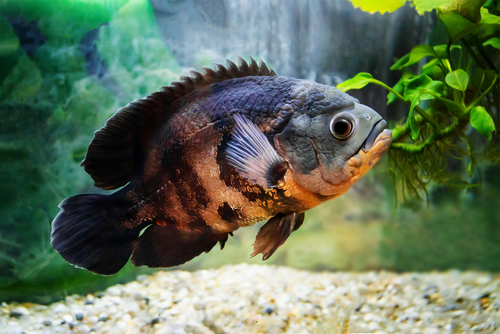
- Scientific Name: Astronotus ocellatus
- Adult Size: 8 to 16 inches
- Compatible With: All Flower Horns
- Water Temperature: 78 to 80 F
- Minimum Tank Size: 55 gallons
- Care Level: Easy
- Origin: South America
This lovely fish is capable of floating along looking pretty unless it encounters anybody small enough to eat. Then it turns into a terrible tank mate!
Luckily, its size and omnivorous diet make it easy to care for in the same tank as a flower cichlid. They do, however, become more aggressive than normal during breeding season and may have to be separated.
Pros of keeping with Flower Horn:
- Similarity in size make infighting unlikely
Cons of keeping with Flower Horn :
- May ignore size similarities and attack during breeding season.
7. Acara cichlid
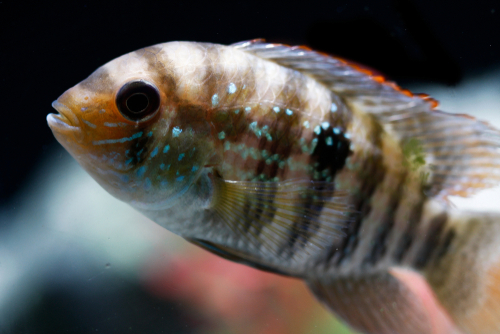
- Scientific Name: Andinoacara pulcher
- Adult Size: 6.3 inches
- Compatible With: All Flower Horns
- Water Temperature: 72 to 86 F
- Minimum Tank Size: 30 gallons
- Care Level: Easy
- Origin: Central and South America
An acara can come in several different hues and not only does its variety in color match well with flower horn cichlids, but its temperament matches well, too. As long as it is not kept with smaller fish and is allowed open tank space, the acara makes a good tank mate.
Pros of keeping with Flower Horn:
- Large enough to avoid infighting
- Many colorful options to match with flower horn
Cons of keeping with Flower Horn :
- None!
8. Common Pleco
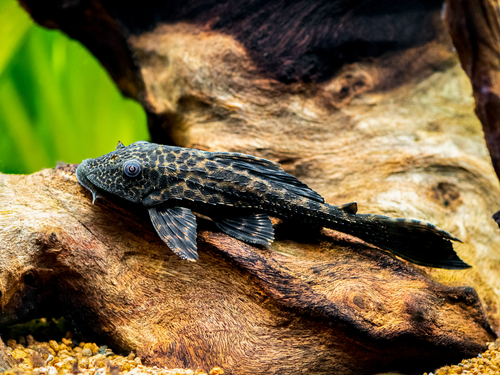
- Scientific Name: Hypostomus plecostomus
- Adult Size: 12 to 24 inches
- Compatible With: All Flower Horns
- Water Temperature: 72 to 86 F
- Minimum Tank Size: 150 gallons
- Care Level: Easy
- Origin: Tobago, Guianas, Brazil
As a break from the many cichlid fish on this list, the common pleco also makes a good tank mate for the flower horn! It is generally friendly with other fish, and because it is passive and lurks around rocks or other tank decorations during the day, it is less likely to cause trouble.
This, plus its large size and algae-cleaning habit, make a common pleco a fantastic tank choice.
Pros of keeping with Flower Horn:
- Cleans up algae
- Passive and nocturnal; unlikely to invite fights!
Cons of keeping with Flower Horn :
- None!
9. Blood Red Parrot cichlid
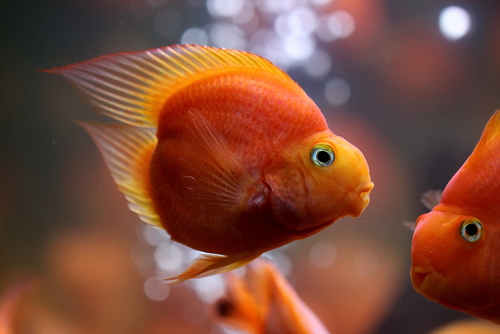
- Scientific Name: Amphilophus Cintrinellus Heros Severus
- Adult Size: 7 to 10 inches
- Compatible With: All Flower Horns
- Water Temperature: 76 to 80 F
- Minimum Tank Size: 150 gallons
- Care Level: Easy
- Origin: Artificial Hybrid
If ever there were a fish that looked like a bird, it is the blood red parrot cichlid! This little creature has the beaklike face, frilly spine, and even eye positioning of a parrot. However, it is the lack of teeth to bite your flower horn with and the comparative sizing that will keep it out of trouble as a flower horn tank mate.
One thing that makes this fish a bit more high maintenance in terms of care is the fact that it needs more food offered daily than other cichlids because of it’s small mouth.
Pros of keeping with Flower Horn:
- No teeth to bite flower horn with
- Big enough to warn off fights with flower horns
Cons of keeping with Flower Horn :
- A bit harder to protect in food competition due to strangely shaped mouth; requires more feeding.
10. Three Spot Cichlid
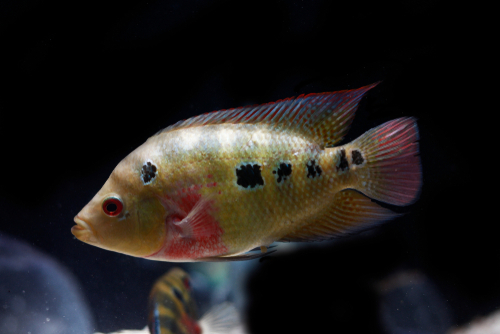
- Scientific Name: Chichlasoma trimaculatum
- Adult Size: 14 inches
- Compatible With: All Flower Horns
- Water Temperature: 74 to 86 F
- Minimum Tank Size: 10 gallons
- Care Level: Easy
- Origin: Western Mexico, El Salvador, Guatemala
Named for the spots along its flank, this fish was actually used to create the breed we now know as flower horn! That said, though it will eat and attack smaller fish, your flower horn is roughly the same size as this fish and they are unlikely to hurt one another.
Pros of keeping with Flower Horn:
- Size similarity discourages bullying
Cons of keeping with Flower Horn :
- None
11. Silver Arowana
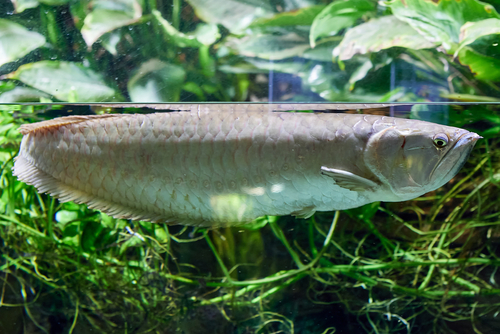
- Scientific Name: Osteoglossum Bicirrhosum
- Adult Size: 48 inches
- Compatible With: All Flower Horns
- Water Temperature: 75 and 86 F
- Minimum Tank Size: 250 gallons
- Care Level: Medium Difficulty
- Origin: Amazon Basin, South America
This fish is actually not terribly aggressive compared to the others on our list, but they are great hunters and are typically larger than flower horn cichlids; it is unlikely they will fight their tank mates. However, the silver arowana is a peculiarly active and flighty fish, and may attempt to jump out of a fish tank if startled or kept in too small a space.
Pros of keeping with Flower Horn:
- Big enough to discourage fighting
Cons of keeping with Flower Horn :
- Easily frightened; may jump out of fish tank that is too small.
12. Bichir Dragonfish
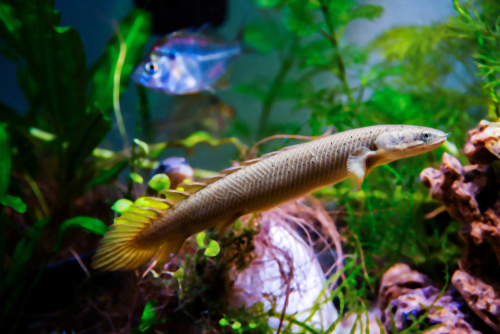
- Scientific Name: Polypterus Senegalus
- Adult Size: 20 inches
- Compatible With: All Flower Horns
- Water Temperature: 75 to 82 F
- Minimum Tank Size: 180 gallons
- Care Level: Easy
- Origin: Africa
Easily one of the most interesting looking fish on this list, the Bichir Dragonfigh skulks along the bottom of the tank like a sea serpent. They are not aggressive and have shortsighted eyes, and your flower horn is not likely to pick a fight with one.
Pros of keeping with Flower Horn:
- Large size and peaceful attitude discourage fighting!
- Little to no competition for similar foods.
Cons of keeping with Flower Horn :
- None!
13. Giant Gourami
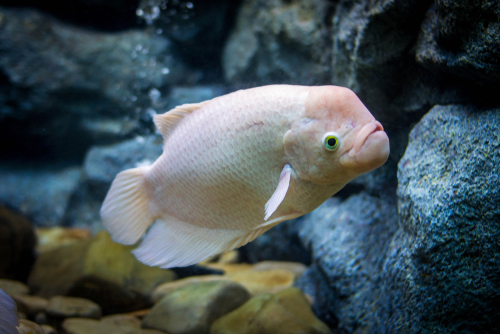
- Scientific Name: Osphronemus goramy
- Adult Size: 18 to 28 inches
- Compatible With: All Flower Horns
- Water Temperature: 82 F
- Minimum Tank Size: 200 Gallons
- Care Level: Easy
- Origin: Southeast Asia
This fish may require a large tank and just as hefty a food diet, but it is this size that makes it a good tank mate for flower horn cichlids. This fish is fun to watch grow, with their funny faces changing the most over time. With enough space, it is not aggressive toward other fish.
Pros of keeping with Flower Horn:
- Non-aggressive
- Big enough to keep flower horns from attacking
Cons of keeping with Flower Horn :
- None, as long as the tank is large enough.
14. Clown Loaches
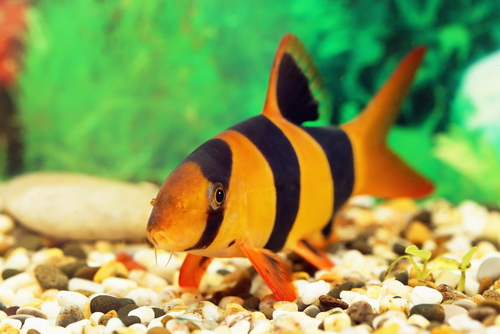
- Scientific Name: Chromobotia Macracanthus
- Adult Size: 7.9 to 11.8 inches
- Compatible With: All Flower Horns
- Water Temperature: 77 to 83 F
- Minimum Tank Size: 100 gallons
- Care Level: Easy
- Origin: Borneo, Sumatra
Not only are clown loaches beautiful with their Tigger-like stripes, but they are fun to watch swimming around in playful spurts! They are not aggressive, though it may look that way because they enjoy playing tag. A few of their interesting traits include playing dead around the bottom of the tank and needing fellow Clown Loaches to interact with.
Though these fish are interesting to watch, you may worry that their non-aggressive nature will lead to bullying from the flower horn. On the contrary, the Clown loaches’ speed and strength in numbers, as well as size, prevents this.
Pros of keeping with Flower Horn:
- Fast enough to avoid bullying
- Large enough to discourage bullying
Cons of keeping with Flower Horn :
- None!
15. Green Terror Cichlid
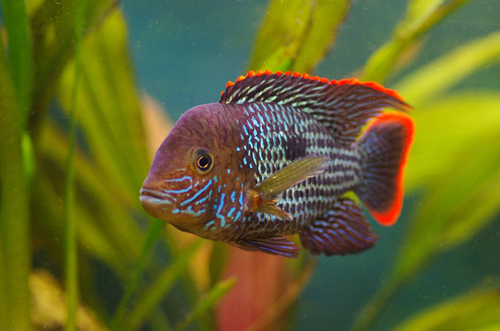
- Scientific Name: Andinoacara Rivulatus
- Adult Size: 6 to 12 inches
- Compatible With: All Flower Horns
- Water Temperature: 69 to 75 F
- Minimum Tank Size: 75 gallons
- Care Level: Medium Difficulty
- Origin: Peru, Ecuador
The only cichlid to match the wolf cichlid for aggressive traits is the Green Terror cichlid. This fish is explorative and must be kept in a tank with plenty of clean, fresh water. Not only that, but if any fish smaller than the Green Terror cichlid crosses it’s path, it is almost certainly a goner.
Luckily, with enough space, the green terror cichlid and the flower horn are similar enough in size that they often leave one another alone.
Pros of keeping with Flower Horn:
- Similarities in size prevent infighting
Cons of keeping with Flower Horn :
- None!
In Conclusion
To sum everything up clearly, flower horn cichlids can only be kept with tank mates that are similar in size and even similar in aggressive temperaments. Many of the best tank mates for flower horns fall under the same cichlid breed, such as wolf cichlids or Midas cichlids.
As long as the other fish are large enough and can handle the warmer tank temperatures and larger space that the flower horn requires, you should have no trouble getting some tank mates for your fishy friend!
Frequently Asked Questions
Can Flowerhorn live with Cichlids?
Yes, flowerhorn cichlids have no problem living with other cichlids, as long as two rules are strictly followed:
- The flower horn cichlid and tank mate cichlids must be fully mature, of similar size.
- There must be at least 150 gallons of water or more in terms of tank size.
As long as both the fish and tank are sized appropriately, there is no reason why your flower horn cichlid shouldn’t get along with other cichlids with only the occasional skirmish.
Can we keep 2 Flowerhorns together?
Flower horn cichlids may be known for their tempers and territorial nature, but they are actually quite content to live with mates, or even other flower horns of the same gender. There may be more chance of infighting if two flower horns are different ages and therefore different in size. Other than this exception, 2 flower horns can live as tank mates peacefully.
Are flower horns aggressive?
As mentioned above, yes, flower horns are known for their aggression! They are intensely fierce during breeding time, and if there are any fish smaller than them around, they are sure to attack. The only hope of keeping flower horns with other fish is if its tank mates are bigger or roughly the same in size.

Ian Sterling, founder of Fishlab.com, began his aquarium journey over 30 years ago, driven by a deep fascination for fish and their diverse personalities. His website, Fishlab.com, is dedicated to making fishkeeping accessible and enjoyable, offering beginner-friendly guidance, expert insights, and a community for aquarists to connect and share experiences.


